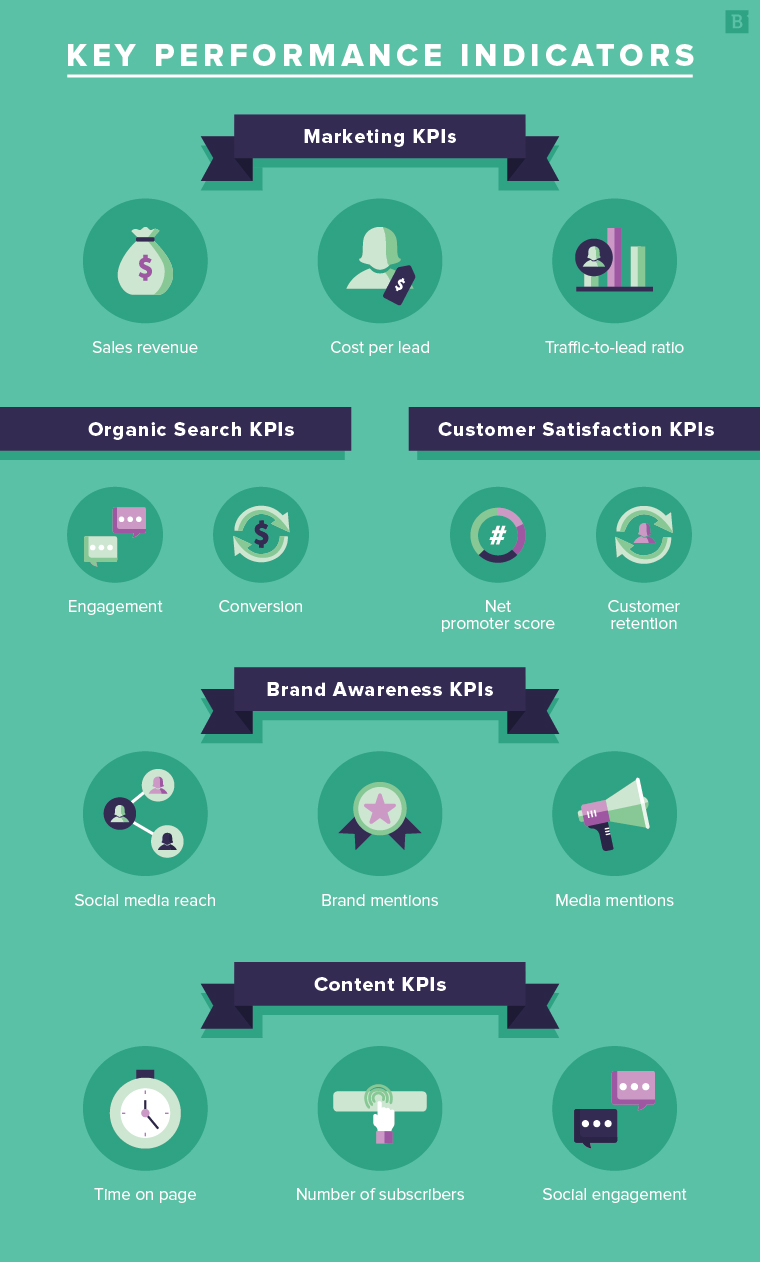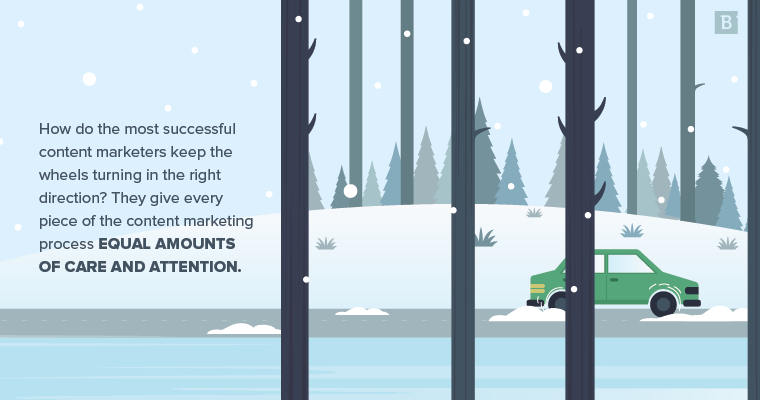How do the most successful content marketers keep the wheels turning in the right direction? They give every piece of the content marketing process equal amounts of care and attention. The result is an organized plan that guides every project from ideation to execution with impressive strategy, creativity and productivity.
Follow-up question: Are you ready to live that life, too?
While each stage of the content marketing process has its own distinctive role to play, there is a common thread that unites them: results. We’re not here to create content for the sake of creating content. We’re here to drive results. That means keeping our end-goals in mind at each stage of the process, letting results and data lead the way.
With the results we want to achieve in mind, onward we go to planning, creating, distributing, promoting and measuring content. Let’s dive in:
Stage 1: The prep
Jumping into anything without a content marketing plan in place is akin to walking down the street with a blindfold on. 100 percent would not recommend. Taking the time to organize your thoughts and define your goals will save you from a lot of headaches and back-tracking later on in the process.
Rally the research
When you’re first developing your content marketing process, you’ll want to answer the who, what, when, where, why and how questions. Your research should include:
- Compiling audience and user insights.
- Brushing up on the latest industry news and trends.
- Exploring content platforms.
- Learning about new tools and technology.
The knowledge you gain from your research will help identify topics that are relevant for your content to address, as well as highlight the content marketing software and tools that may be helpful throughout the process. Don’t forget to return to this step periodically so your knowledge doesn’t go stale.
Get to know your audience
One of the most important things to come out of this planning stage is your target audience. Consider the problems your product or service aims to solve, and who might experience a need for those solutions. Think about your current clientele, noting whether your typical buyers are the ideal customers for your product or service. Search for your competitors and list out the reasons why consumers should choose your brand instead.
From there, you can start asking the more hard-hitting questions about your target audience. You don’t want acquaintances, you want close friends. Not to be creepy, but you ideally want to know as much as possible about their demographics, personal and professional goals, pain points, fears, quirks, dreams and everything in between. The better you know your audience, the more likely you are to create the tailored content that truly resonates with them.
Your research will help you create buyer personas that you can reference each time you create a new piece of content.

Establish goals
What are the results you’re hoping to achieve from your content marketing efforts? Increased traffic? Higher-quality leads? More revenue? Lots of brand mentions? Better conversions? All of the above?
You’ll want to define these goals before starting any content marketing campaign because they inform all the decisions you’ll need to make along the way. Be SMART when you’re setting goals, making them specific, measurable, actionable, realistic and timely.
Next up is identifying the key performance indicators that help you determine how your content’s performance stacks up to the intended results.

Don’t let these goals leave your mind from here on out. They’ll serve as the challenges for your content marketing strategy to overcome, the purpose behind your content creation and the fuel for distribution and measurement.
Important note: While your content marketing goals are a must-have before you do anything else, they’re not set in stone. Revisit them frequently to make sure they still align with company-wide goals and offerings, as well as industry and consumer trends.
Stage 2: The strategy
Your content marketing strategy is the guiding light for all upcoming stages. In the simplest terms, your strategy determines what content you’ll create and where it will live once it’s ready for distribution. It also ties back to your goals, addressing why you’re creating such content and what it’s intended to achieve. Finally, your content marketing strategy should outline how you’ll measure success, including which KPIs you’ll track.
Determine your current status
As you start crafting your content strategy, take a hard look at what you’re working with. Perform content, website and social media audits to gauge your current performance. When you have a better idea of your current top landing pages, typical traffic sources, social media engagement levels and other content performance, you’ll know where you stand in terms of reaching your desired results. This includes understanding which elements are already working as well as those that are in dire need of improvement – all of which can help shape your strategy.
Find your target keywords
Now it’s time to identify those magic words and phrases that will get your content in front of your target audience. Start your keyword discovery by building a list of words and phrases you already identify with your brand. Take your marketing hat off for a moment and think about how your ideal consumer might search for your product or service. Add those words or phrases to your list as well.
Use keyword research tools like Google Analytics, SEMrush and Moz Keyword Planner to identify which words on your list have a reasonable search volume – usually one of at least 100. Aim for a healthy mix of search volumes on your keyword list. While a search volume of 12,500 certainly means the keyword or phrase is popular, it will also be more difficult to rank for than a keyword with 125 searches. Keyword research tools can also provide keyword suggestions based on these search volumes and current trends.
Iron out the details
Think strategically about what kind of content you’re going to create, as well as which channels you’re going to publish said content on. As you might expect by now, your goals and KPIs can help inform these decisions. Blog posts, for example, are a great opportunity to use keywords and boost page rankings. Videos drastically enhance landing page performance, while gated content like white papers and eBooks are ideal for increasing qualified leads.
Plan your content calendars
When you have a better idea of the type of content you need, create a schedule to make it all happen. Editorial-wise, make sure you allow ample time for writing, editing and designing when you map out deadlines. Stay organized with a spreadsheet or online project management tool that your entire team can access.
It helps to create a separate social media calendar, especially if you’re using an online scheduling platform. You’ll want to keep your social presence consistent but always relevant, and remember to mark your calendar with fun social media holidays to sprinkle in some personality.
Pro tip: While both editorial and social calendars call for original content creation, you can also schedule time for content curation. Share industry news and research from credible sources, for instance, or repost content that features your company or employees.

Stage 3: The content creation
Using your content strategy as a guide, it’s finally time to create the engaging content tailored perfectly to your audience. Work with sales enablement in mind for the added bonus of creating the content that can help your sales team engage interested buyers and drive more revenue.
Brainstorm topics
Your content ideas will stem from your strategy and, of course, should align with your desired results. For instance, creating a product demo can boost brand awareness while writing a how-to blog can answer the burning questions your target consumers frequently search. When you’re facing writer’s block, there are some fabulous content ideation tools that can help you escape from the dark place.
Find your voice
Being consistent with your brand’s tone of voice is key for making every piece of content uniquely yours. Your voice complements your brand personality and reinforces the image you want consumers to have of your company.
The key to establishing the right tone is thinking about how you want your audience to feel after reading your content. Empowered? Informed? Thoughtful? Your brand voice should spark those desired reactions.
Get creative
Here’s where the writers, designers and videographers get to show off their talents, creating blogs, eBooks, infographics, videos and other content outlined in the strategy. When time allows, throw your heart and soul into it and create the epic content that will make your target audience stop in their tracks. Epic content is more than your average blog post, running the extra mile to provide super useful information in ultimate-guide fashion. Original research helps boost exclusivity, and eye-catching visuals make the experience that much better.
Side note: You don’t have to tackle all this content creation on your own. Here’s our take on the best online tools in the industry that can get you to the top of your content marketing game.
Stage 4: The distribution
With the creation phase complete, you’re finally ready to share your content with the world.
Establish publishing cadence
Publish your content on the channels identified in your strategy, referencing your content calendars to make sure you’re staying on track with deadlines. Whether you’re using an online platform or proprietary software, make sure you have a process in place for publishing blog posts and creating landing pages for gated content.
Promote your content
Once it’s on your site, don’t rely on just your keyword usage to get your content in front of viewers. Make sure your target keyword is in your title tag and write compelling meta descriptions that entice users to click on your link. (Psst: Here are more page one ranking secrets for ya.)
You’ll also want to promote your content on your social media feeds and use email marketing to make sure everyone on your list has a higher chance of seeing your content. Make sure your sales team also promotes your brand’s content as part of their sales process. Landing pages, one-pagers and videos that cover your products and services are great selling tools.
Stage 5: The measurement
Making it to this stage means you’re ready to collect the data and analyze your content’s performance. These numbers also provide proof for the content marketing ROI you promised your boss.

Use analytics tools
Online resources like Google Analytics, SEMrush and Kissmetrics make it easy to collect data on content performance. They’ll even present the information in useful charts, graphs and reports to help you interpret the data.
Get used to reports
You’ll want to pull regular reports so you can track changes over time. In general, you can focus on specific metrics in weekly and monthly reports, while quarterly and annual reports will provide a higher-level look at the progress you’re making toward your goals.
Act on the data
So what exactly is all that data telling you? The insights you gain from the reports will help you determine your next steps. Maybe your research led you to believe Facebook was the place to be, but the data actually shows little engagement. You’ll want to dig deeper to determine if changes in your strategy or execution are necessary to boost engagement in the future.
Now rinse and repeat
Congrats! You made it through all the stages of the content marketing process. Unfortunately, though, your work is far from done.
Remember that a successful content marketing process is cyclical, meaning every stage needs constant refreshing to maintain relevance and effectiveness. It should be clear and defined, yes, but also flexible enough for easy adaptation to changes in market trends, consumer behavior and marketing technology.
So without further ado, it’s your turn to take the driver’s seat. Here are some content marketing best practices for extra support as you work through each stage. Good luck!





